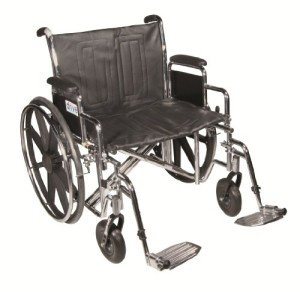bariatric wheelchair recliner
Having the correct seat width is essential to wheelchair users who spend longer periods in their chairs. Too narrow a seat will cause pressure on the hips and thighs which might lead to sores or pressure points. Having too broad a seat can also make it challenging for the user to reach the hand rims to propel themselves or maneuver in small areas.
To determine the correct seat width an individual would rest on a chair typically and have their measurement taken throughout their lap at the widest point which is typically their hips. A wheelchair determining tape can be used to measure this, but a lawn stick is preferred as it avoids individuals from wrapping the tape around their hips which would offer an inaccurate outcome.
The standard wheelchair seat width is 16" (narrow grownup), 18" (basic adult), and 20" (broad adult). For bariatric patients, a 24" seat is offered. This durable additional wide bariatric wheelchair from Medline features swing-away footrests, a carbon steel frame with rust- and chip-resistant chrome plating, and easy-to-clean vinyl upholstery. It has a weight capacity of 500 pounds.
Seat Depth
Generally, the seat depth of a bariatric wheelchair was included 2" to the measurement taken at the user's largest point (generally their hips). This was suggested to accommodate extra layers of clothes that might be used during cold weather. Nevertheless, this practice is ending up being less typical as wheelchair users have the ability to invest more time inside your home and are not using long coats. This makes the seat depth of a chair lesser when selecting a bariatric wheelchair. However, it is still crucial to choose a choice that provides sufficient assistance for larger users.
The Medline folding additional broad bariatric manual wheelchair features a comfy 24" seat width and a durable slide tube silver vein frame. It likewise has an adjustable axle and tool-free raising legrests.
Seat Height
When it comes to determining the appropriate wheelchair seat width you should constantly measure from the user's best point which is generally their hips. You will likewise need to think about whether the user is going to be using a winter season coat as this may add 2" to the width needed.
When a wheelchair remains in usage it must only be operated on level surfaces with the wheel locks totally engaged. This is to prevent the chair from being able to move slopes that are 10 degrees or greater. It is likewise crucial to remember that any activity that may move the center of mass in the chair need to be made with care. This includes grabbing items that need the individual to lean out of their seat or trying to stand up from it.
Whenever you have the chair in usage it is suggested that you frequently check it for damage and lubricate any locations that are considered essential. For instance, the casters must be lubed by eliminating the caster fork and utilizing a multi-purpose grease to apply to the caster stem bearings. Also, the foot plates can be adjusted by loosening the bolt and then moving them to the wanted position. This enables the feet to sit easily on the footplate and avoids any pressure points from forming. This can be very uneasy for the user and if left unattended, can result in push sores.
Weight Capacity

Bariatric wheelchairs are created to support more weight than basic wheelchairs. This makes them tougher and better equipped to handle falls. They are likewise normally bigger and larger, making them less maneuverable in tight spaces than standard wheelchairs. They need automobiles with unique ramps and lifts to pack them, in addition to chauffeurs who know how to best transport them from one location to the next.
When picking a wheelchair, consider its weight capacity as it will be the primary determining consider whether it will accommodate your guest's requirements. The weight capacity of the chair is often noted as a static load, meaning that it indicates the quantity of weight the chair can conveniently hold while standing still. Nevertheless, some producers likewise note an active load that is based on a drop test and can mimic the result of someone taking a seat in the chair. This may be a more dependable measurement of the weight limit, depending upon your requirements.
If you prepare to carry out activities that move your center of gravity in the seat (such as grabbing things), make sure to have front casters pointed in a forward instructions and wheel locks engaged so the chair will not topple. Likewise, examine that casters are oiled routinely to prevent excessive wear and abrasions. The lubrication procedure involves removing the fork, separating the caster from the wheel, and greasing the caster stem bearings with top quality multi-purpose grease.
